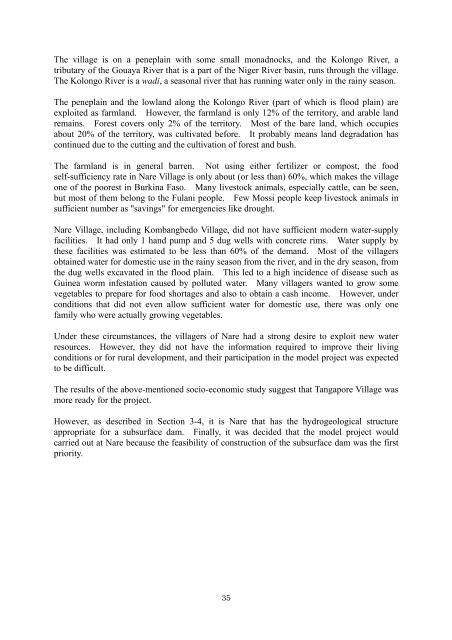SubSurface Dams - Sustainable Sanitation and Water Management ...
SubSurface Dams - Sustainable Sanitation and Water Management ...
SubSurface Dams - Sustainable Sanitation and Water Management ...
Create successful ePaper yourself
Turn your PDF publications into a flip-book with our unique Google optimized e-Paper software.
The village is on a peneplain with some small monadnocks, <strong>and</strong> the Kolongo River, atributary of the Gouaya River that is a part of the Niger River basin, runs through the village.The Kolongo River is a wadi, a seasonal river that has running water only in the rainy season.The peneplain <strong>and</strong> the lowl<strong>and</strong> along the Kolongo River (part of which is flood plain) areexploited as farml<strong>and</strong>. However, the farml<strong>and</strong> is only 12% of the territory, <strong>and</strong> arable l<strong>and</strong>remains. Forest covers only 2% of the territory. Most of the bare l<strong>and</strong>, which occupiesabout 20% of the territory, was cultivated before. It probably means l<strong>and</strong> degradation hascontinued due to the cutting <strong>and</strong> the cultivation of forest <strong>and</strong> bush.The farml<strong>and</strong> is in general barren. Not using either fertilizer or compost, the foodself-sufficiency rate in Nare Village is only about (or less than) 60%, which makes the villageone of the poorest in Burkina Faso. Many livestock animals, especially cattle, can be seen,but most of them belong to the Fulani people. Few Mossi people keep livestock animals insufficient number as "savings" for emergencies like drought.Nare Village, including Kombangbedo Village, did not have sufficient modern water-supplyfacilities. It had only 1 h<strong>and</strong> pump <strong>and</strong> 5 dug wells with concrete rims. <strong>Water</strong> supply bythese facilities was estimated to be less than 60% of the dem<strong>and</strong>. Most of the villagersobtained water for domestic use in the rainy season from the river, <strong>and</strong> in the dry season, fromthe dug wells excavated in the flood plain. This led to a high incidence of disease such asGuinea worm infestation caused by polluted water. Many villagers wanted to grow somevegetables to prepare for food shortages <strong>and</strong> also to obtain a cash income. However, underconditions that did not even allow sufficient water for domestic use, there was only onefamily who were actually growing vegetables.Under these circumstances, the villagers of Nare had a strong desire to exploit new waterresources. However, they did not have the information required to improve their livingconditions or for rural development, <strong>and</strong> their participation in the model project was expectedto be difficult.The results of the above-mentioned socio-economic study suggest that Tangapore Village wasmore ready for the project.However, as described in Section 3-4, it is Nare that has the hydrogeological structureappropriate for a subsurface dam. Finally, it was decided that the model project wouldcarried out at Nare because the feasibility of construction of the subsurface dam was the firstpriority.35
















